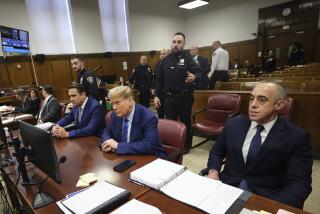Spector jury to again seek a verdict
- Share via
Jurors in the Phil Spector trial will resume deliberations today, two weeks after they first began considering whether the famous music producer murdered actress Lana Clarkson, and four days after the judge launched an extraordinary effort to break a jury deadlock.
Spector, 67, is accused of killing Clarkson, 40, who was found shot to death in his Alhambra mansion on Feb. 3, 2003.
Prosecutors say Spector shot Clarkson when she tried to leave against his wishes. Spector’s attorneys say she was depressed over her faltering career and money problems and shot herself.
Friday was the jury’s first full day of deliberations since the panel announced an impasse Tuesday, spurring Los Angeles Superior Court Judge Larry Paul Fidler to issue new jury instructions that legal experts said may have created more problems than they solved.
After seven days of deliberations, jurors said they were split 7-5 and did not think they could move past their differences. Fidler told the jurors not to reveal whether the majority favored guilt or innocence, but asked if they thought anything could help them resolve their deadlock.
Several jurors said they found confusing an instruction stating that in order to convict Spector, they had to conclude that he had held the gun that went off in Clarkson’s mouth.
After three days of discussion between the judge and the attorneys -- and over the intense objections of the defense -- Fidler told jurors to disregard the instruction, and in its place consider one that introduced several scenarios of how Spector might have shot Clarkson.
Among them were that he forced the gun into her mouth, or that during a struggle the gun entered her mouth and went off.
Fidler cautioned the jurors that “by using these examples, I am not suggesting that any of these acts took place. These are inferences you may draw from the evidence but are not required to do so. You may reject them. These are only possibilities that you may consider.”
But several legal scholars said the new instruction could render any conviction that might result vulnerable on appeal.
“When you change course midway through when you think you have done something wrong, it is not always possible to unring all those bells you have already rung,” said Jean Rosenbluth, a USC law professor who monitored the trial.
Despite being at loggerheads over the case, the jury of nine men and three women appear genuinely fond of each other. Middle-aged and racially mixed, they arrive with doughnuts and coffee, and appear cheerful. Laughter can be heard from behind their closed door at breaks. During the lunch hour, they can be seen chatting amiably in the parking lot, intermingling without breaking apart into any obvious factions. They have been through 33 hours of deliberations.
Since the reading of the new instructions Thursday afternoon, the jurors asked no questions of the court.
On Friday, they took a shorter lunch break than their normal 90 minutes, and ended their day about 45 minutes early, departing about 3:10 p.m., leaving no clues as to what they are thinking.
--
More to Read
Sign up for Essential California
The most important California stories and recommendations in your inbox every morning.
You may occasionally receive promotional content from the Los Angeles Times.













